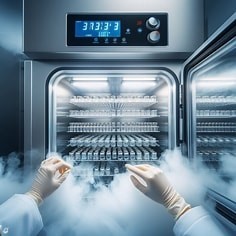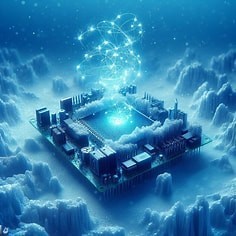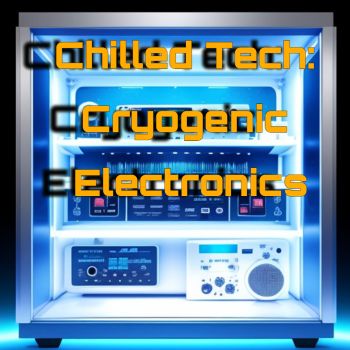Introduction
Definition of Cryogenic Electronics
Cryogenic electronics refers to the study and development of electronic devices and circuits that operate at extremely low temperatures, typically much colder than room temperature. This typically ranges from around -150°C to a few millikelvins (-273.15°C).
The primary goal of cryogenic electronics is to increase the effectiveness, dependability, and performance of electronic systems by taking advantage of the special qualities of materials and electrical components at cryogenic temperatures.
Superconductors, which exhibit zero electrical resistance at low temperatures, and low-temperature semiconductors are integral elements in the design of cryogenic electronic circuits. Applications for this topic can be found in sensors, quantum computers, and communication systems, among other cutting-edge technology. Cryogenic electronics make use of the characteristics of materials at very low temperatures to enable the development of innovative devices with performance and capabilities never before seen.

Basics of Cryogenic Electronics: An Introduction to Cryogenics:
The study and application of extremely low temperatures constitute the focus of the engineering and physics discipline known as cryogenics. The Greek words “kryos,” which means cold, and “genes,” which means born or formed, are the source of the word “cryogenics”.
In practical terms, cryogenics involves the handling and utilization of materials and systems at temperatures below -150 degrees Celsius (-238 degrees Fahrenheit), often reaching as low as absolute zero (-273.15 degrees Celsius or 0 Kelvin).
At such low temperatures, many gases undergo changes in their physical states, transitioning from gases to liquids and, in some cases, to solid form. Liquid nitrogen and liquid helium are typical cryogenic fluids.
Materials at cryogenic temperatures have special qualities that are advantageous for the development of science and technology. Studies of unusual physical phenomena, such as superconductivity—where some materials exhibit zero electrical resistance—or quantum effects—which grow more pronounced at very low temperatures—are conducted in cryogenic conditions.
Importance of Low Temperatures in Electronics
The importance of low temperatures in electronics lies in the unique physical behaviors and advantages that emerge at extremely cold conditions. Here are several key reasons why low temperatures are crucial in electronic applications:
1. Reduced Electrical Resistance: At low temperatures, certain materials, known as superconductors, exhibit zero electrical resistance. This property enables the creation of superconducting circuits, which can transmit electrical signals without any loss, resulting in highly efficient and high-performance electronic systems.
2. Quantum Effects: Low temperatures reveal and enhance quantum effects in electronic components. Quantum phenomena, such as superposition and entanglement, become more pronounced, forming the basis for technologies like quantum computing. Operating at low temperatures helps maintain the delicate quantum states necessary for the reliable functioning of quantum devices.
3. Improved Semiconductor Performance: Lowering the temperature of semiconductors can enhance their performance by reducing thermal noise and increasing carrier mobility. This improvement is crucial for applications such as high-frequency communication systems, where signal integrity and speed are paramount.
4. Cryogenic Sensors: Many sensors, particularly in scientific and aerospace applications, benefit from cryogenic temperatures. Cooling sensors to low temperatures increases their sensitivity and reduces background noise, making them more effective for precise measurements in fields like astronomy and medical imaging.
Cryogenic Freezer
A cryogenic freezer is a specialized appliance designed to achieve and maintain extremely low temperatures, often approaching or reaching cryogenic levels. These freezers use cryogenic fluids, such as liquid nitrogen or liquid helium, to create a frigid environment, typically below -150 degrees Celsius (-238 degrees Fahrenheit). Cryogenic Freezers are commonly used for the long-term preservation of biological samples, medical specimens, and scientific materials due to the ultra-low temperatures that slow down molecular and chemical processes, effectively preserving the contents.
Cryogenic Technology
Cryogenic technology encompasses a range of scientific and engineering principles focused on the study and application of extremely low temperatures, typically below -150 degrees Celsius (-238 degrees Fahrenheit). Here’s a detailed explanation:
1. Cryogenic Fluids:
– Cryogenic technology often relies on specialized fluids with extremely low boiling points, such as liquid nitrogen, liquid oxygen, and liquid helium.
– These cryogenic fluids are used for various purposes, including cooling and preserving materials, as well as creating ultra-cold environments for scientific experiments.
2. Superconductivity:
– One of the key phenomena studied and applied in cryogenic technology is superconductivity.
– Superconductors, materials that exhibit zero electrical resistance at low temperatures, are used in various applications, including powerful electromagnets, high-speed maglev trains, and advanced electronic components like superconducting qubits in quantum computers.
3. Cryogenic Cooling Systems:
– Cryogenic cooling systems are designed to achieve and maintain extremely low temperatures.
– These systems often use a combination of compressors, heat exchangers, and expansion valves to control the flow of cryogenic fluids and extract heat from the target system or material.
Cryogenic Cooling Systems
Cryogenic coolants are specialized fluids used to achieve and maintain extremely low temperatures in cryogenic applications. Here are some common types of cryogenic coolants:
Liquid Nitrogen (LN2):
Widely used in various applications due to its low boiling point of -196 degrees Celsius (-321 degrees Fahrenheit).
Commonly employed in cryopreservation, medical procedures, and as a coolant in scientific research.
Liquid Oxygen (LOX):
Used in cryogenic applications due to its low boiling point of -183 degrees Celsius (-297 degrees Fahrenheit).
Finds applications in medical and aerospace industries.
Liquid Hydrogen (LH2):
Used as a cryogenic coolant with a boiling point of -253 degrees Celsius (-423 degrees Fahrenheit).
Commonly utilized in rocket propulsion and certain laboratory applications.
Liquid Helium (LHe):
Operates at even lower temperatures with a boiling point close to absolute zero at -269 degrees Celsius (-452 degrees Fahrenheit).

Cryogenic Materials:
Cryogenic materials are substances that exhibit unique and often remarkable properties at extremely low temperatures, typically below -150 degrees Celsius (-238 degrees Fahrenheit). Here are some common types of cryogenic materials:
Superconductors: Materials that, at cryogenic temperatures, exhibit zero electrical resistance and the expulsion of magnetic fields. Superconductors play a key role in technologies like superconducting quantum devices and high-field magnets.
Low-Temperature Semiconductors: Semiconductor materials are designed to operate efficiently at cryogenic temperatures.
Cryogenic Insulators: Insulating materials crafted to maintain their insulating properties in extremely low temperatures are referred to as cryogenic insulators.
Thermal Insulation Materials: Materials specifically engineered to minimize heat transfer at cryogenic temperatures are termed thermal insulation materials.
Cryogenic Gases: Gases existing in a cryogenic state, like liquid helium, liquid oxygen, and liquid nitrogen, are denoted as cryogenic gases.
Cryogenic Polymers: : These materials are formulated to withstand low temperatures while maintaining their mechanical properties.

Conclusion:
Cryogenic electronics is, to put it briefly, like plunging into a chilly pool of creativity! It ultimately comes down to harnessing extremely low temperatures to enable incredible technological breakthroughs, such as mind-bending quantum computing and space exploration. Prepare for a surge of revolutionary discoveries that will fundamentally alter the way we work and live as we go deeper into this frigid domain.
Frequently Asked Questions FAQ
Q: What is cryogenic cooling?
A: Cryogenic cooling involves the use of extremely low temperatures, typically below -150 degrees Celsius (-238 degrees Fahrenheit), to cool and maintain the temperature of materials or devices. Cryogenic fluids, such as liquid helium or nitrogen, are frequently used in this procedure to reach and maintain the required low temperatures. The preservation of biological samples, enhancement of electronic component performance in cryogenic electronics, and support for scientific studies necessitating extremely low temperatures to observe unusual physical phenomena like superconductivity are applications for cryogenic cooling.
Q: Are cold electronics and cryogenic electronics different?
A:: “Cold electronics” and “cryogenic electronics” are often used interchangeably, both referring to systems operating at low temperatures. However, “cryogenic electronics” more specifically emphasizes extremely low temperatures, including those near absolute zero. The distinction lies in the degree of coldness, with “cryogenic” typically indicating more extreme conditions.

